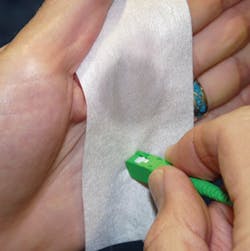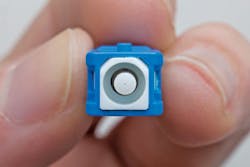The essentials and evolution of fiber cleaning
From the February, 2015 Issue of Cabling Installation & Maintenance Magazine
Answers to some of today's most relevant and pressing questions about fiber connectivity and cleaning.
By Mike Jones, MicroCare Corp.
We recently had the opportunity to pose a handful of questions to Mike Jones, vice president of MicroCare Corp., which offers the Sticklers brand (www.sticklerscleaners.com) of fiber-optic cleaning equipment. Jones elaborated on some of the most relevant questions concerning fiber cleaning, as well as the evolution of cleaning processes and tools that parallels the evolution of fiber-optic connectivity.
Q: While use of fiber optics is increasing worldwide, the reluctance to clean fiber connections remains. All these people can't be wrong. What's the importance of fiber cleaning?
A: You are exactly right. Across the globe customers say, "I don't have the time, or the budget, or the tools, to properly clean my fiber." There always is some excuse that stops them from doing what needs to be done.
What technicians and managers don't realize is that they are going to pay for cleaning, sooner or later. Modern high-speed networks actually are more sensitive to dirt than older, slower networks are. So companies can either spend 20 cents to clean a connector when they are installing it, or they can spend hundreds of dollars on a return visit, troubleshooting and reworking until they find the pesky little particle of dust that is bringing their network to its knees.
One telco reported that the average, fully loaded cost of a fiber field repair is US$200. Another company reported that 16 percent of their fiber links fail exclusively due to contaminated connections and splicing. There's just no faster way to kill a network than failing to clean.
Here's the more important truth that all customers, installers and network operators need to understand: It's far, far cheaper to clean than to repair.
Q: Questions often are asked about the appropriateness of using wet, dry, and combo wet/dry cleaning practices. Does MicroCare have a recommendation that goes across the board, or does it vary by fiber application or environment?
A: In general, wet-dry cleaning is the optimal answer. The reason is due to an unexpected characteristic of fiber: The fiber itself and the connectors are not made with electrically conductive materials. This means that a dry wipe across a fiber endface will impart an electrostatic charge onto that endface. This "triboelectric effect" is very common; just walking on a synthetic carpet can create a spark when you touch a doorknob, or rubbing a child's balloon, or even just combing your hair can impart a triboelectric charge to the nonconductive material. Because that static charge has no place to go, it turns the fiber connector into a tiny magnet, attracting dust right to the endface. Get rid of the static and you'll get rid of the dust.
To properly clean fiber endfaces, you need to dissipate the static. The best way to do this is by using a static-dissipative fluid in conjunction with the wipe.
But there are exceptions to this rule. Normal fiber wipes are neither static-dissipative not lint-free, and the packaging in which they come doesn't help either. Our fiber-optic cleaners actually feature two products that are engineered for dry wiping. The wipe is a unique cloth--not paper--and the box features metal foils to dissipate any static charge. But if technicians are not using special, static-dissipative products like those it is essential they use a fluid when cleaning endfaces.
Q: Technicians are often tempted to use consumer-quality products for their cleaning tools--mainly off-the-shelf isopropyl alcohol and canned-air sprayers--for fiber cleaning. A good, money-saving idea, or not?
A: Consumer products generally do not meet the demanding requirements of fiber-optic applications. So let me be blunt: Bad tools produce bad results. Get your technicians the right tools and your network will run far more reliably.
If you need proof, one example is Bell Labs. When they were pioneering fiber-optic installation processes in the 1970s, their technicians used "reagent grade" isopropyl alcohol (IPA). This is a super-pure version of alcohol, devoid of water to four decimal places, filtered to remove particulate and packaged properly. It actually is a pretty good cleaner. It's also expensive, hard to store and impossible to keep uncontaminated in day-to-day operations.
Today, no field technician in the world has access to reagent-grade IPA when they are down in a manhole. The cheap alcohol they will be using will be diluted with about 30 percent water. This weak alcohol mix will be sold in dirty 1-liter plastic bottles that will leach plasticizers into the fluid. The alcohol mix will be poured in leaky, non-air-tight, reusable pump bottles, which conveniently ensures the dirt inside the bottle migrates onto every endface. Lastly, in an effort to be economical, the technician will re-use a wipe and the alcohol on multiple endfaces. The cleaning results they will see with their cheap, drug-store-grade alcohol will not in any way resemble the results Bell Labs, IPC (Association Connecting Electronics Industries; www.ipc.org) and iNEMI (International Electronics Manufacturing Initiative; www.inemi.org) get in their labs.
So spend the few extra cents and get cleaning chemicals, wipes, and swabs that are engineered for fiber-optic applications. The extra money spent on proper supplies will be more than offset by the repair visits you do not have to make on your fast, reliable and clean fiber network.
Q: MPO-style connectors have surged in popularity, and they present unique cleaning challenges. Can you describe what these challenges are and how they can be met?
A: MPO/MTP connectors are both a blessing and a curse. They are an enabling technology that allows vast quantities of data to be moved through a very small physical footprint. However, they are extremely vulnerable to contamination. Because they're so hard to clean, technicians often simply skip the cleaning step and assume the endface will be good enough.
But it's not the design of the connector that's the heart of the problem; it's the quantity of these connectors that makes the difference. In a big data center, there may be hundreds or even thousands of MPO connectors that need to be cleaned as networks are moved and reconfigured. That means technicians need tools that give them fast, reliable cleaning in seconds.
Without any doubt, the best tool for that job is a "push-to-click" cleaning tool. These MPO cleaning tools are becoming more widely available, from a number of companies including Sticklers Cleaners. Just make sure you get a quality tool, because a cheap, poorly made tool can actually damage endfaces and also break apart in your hands--which are two excellent ways to increase your cleaning costs unhappily.
Q: MicroCare makes cleaning products for a number of industries in addition to fiber optics. Are there any best practices or "lessons learned" from other industries that can benefit fiber-optic technicians?
A: Yes, there is one in particular, and the answer is simple: Processes matter.
A good process is a simple recipe. Just like in the kitchen, good processes specify the tools, the ingredients and the methods of preparation. What we see in other industries, and so often fail to see in the telecom industry, is the proper definition and enforcement of good process.
Years ago I was an air traffic controller. One of our standard jokes about pilots was, "You can't get lost if you don't care where you are going." The same is true for fiber optics. If you don't really care about the network, if you don't really understand the proper way to do the job, if you don't really know that modern, high-speed networks are positively fragile, then there is no wonder that people try to clean their endfaces on their shirtsleeve.
Companies need to take the time to research best practices--IPC, iNEMI and BICSI are great resources--and develop, teach and deploy those practices on their networks. The alternative is ever-higher repair costs, unhappy customers and lost business--the quick road to failure.
Get your processes right, use the right tools, reward your people for doing the right job, and the networks will work fast and fine.
Q: What question do fiber technicians ask you most frequently?
A: That's an easy one. The question I hear all the time is, "This patch cord is brand new, right out of the box. Do I need to clean it?"
The answer is yes, you definitely need to clean every patch cord, both sides, every time, even brand new ones just out of the bag.
The reasons are fourfold.
- In the factory where the patch cord is made, there's a manager trying to increase profitability. They will skimp on cleaning because (they think) the field technician is going to clean the connector before installing it. So why should the factory spend the money on cleaning?
- In addition, if they do clean in the factory, they usually do it poorly, using a dirty wipe that has been used to clean hundreds of connectors.
- But it gets worse. Once they have made this feeble attempt at cleaning, they pop a "dust cap" over the endface. Dust caps are injection-molded, by the thousands, and they are shipped in dirty cardboard boxes to patch-cord factories, grinding against themselves and picking up all sorts of dust en route. Of course these dust caps are not cleaned themselves before being inserted on the endface, so all that debris easily migrates from the dust cap to the endface in months of transit and storage.
- Then there is one last worry. These dust caps are made of the cheapest plastic money can buy. When they finally are inserted on top of the fiber endface, they will out-gas plasticizers. These flumes float in the air on top of the endface and gradually settle onto the endface, perfectly happy to disrupt your data and ruin your day.
So if there is one thing your readers take away from this Q&A, let it be this: Clean your brand-new patch cords, both sides, every time. Your network will thank you.
Mike Jones is vice president of MicroCare Corp. (www.sticklerscleaners.com).
Archived CIM Issues


